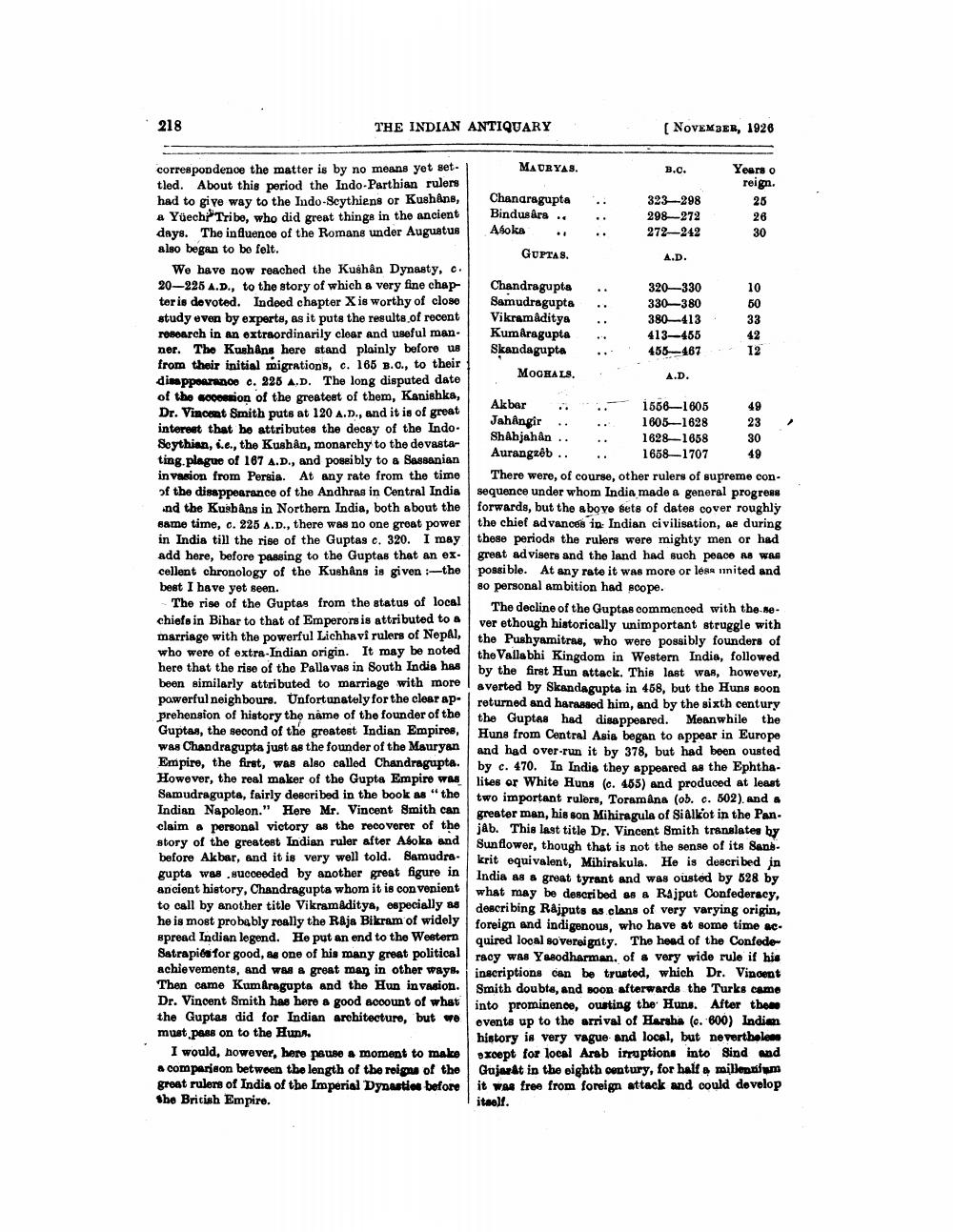________________
218
THE INDIAN ANTIQUARY
NOVEMBER, 1926
MAURYAS.
B.O.
Years o
reign.
..
26
Chandragupta Bindusars .. Afoka .
GUPTAS.
323298 298272 272242
26
..
A.D.
..
Chandragupta Samudragupta Vikramaditya Kumâragupta Skandagupta
MOCHALS.
320—330 330—380 380—413 413—455 455-467
..
1
2
A.D.
23
correspondence the matter is by no means yet set tled. About this period the Indo-Parthian rulers had to give way to the Indo-Seythiens or Kushing, a Yüech? Tribe, who did great things in the ancient days. The influence of the Romans under Augustus also began to be felt.
We have now reached the Kushân Dynasty, c. 20-225 A.D., to the story of which a very fine chapter is devoted. Indeed chapter X is worthy of close study even by experts, as it puts the results of recent roboarch in an extraordinarily clear and useful man. ner. The Kushåns here stand plainly before us from their initial migrations, c. 165 B.C., to their disappearance c. 226 A.D. The long disputed date of the woocomion of the greatest of them, Kanishka, Dr. Vincent Smith puts at 120 A.D., and it is of great interest that he attributes the decay of the Indo. Scythian, i.e., the Kushån, monarchy to the devasta ting.plague of 167 A.D., and possibly to a Sassanian invasion from Persia. At any rate from the time of the disappearance of the Andhras in Central India .nd the Kusbåns in Northern India, both about the same time, c. 225 A.D., there was no one groat power in India till the rise of the Guptas c. 320. I may add here, before passing to the Guptas that an ex. cellent chronology of the Kushåns is given :--the best I have yet seen.
The rise of the Guptas from the status of local chiefs in Bihar to that of Emperors is attributed to a marriage with the powerful Lichhavi rulers of Nepal, who were of extra-Indian origin. It may be noted here that the rise of the Palla vas in South India has been similarly attributed to marriage with more powerful neighbours. Unfortunately for the clear apprehension of history the name of the founder of the Guptas, the second of the greatest Indian Empires, was Chandragupta just as the founder of the Mauryan Empire, the first, was also called Chandragupta. However, the real maker of the Gupta Empire was Samudragupta, fairly described in the book as "the Indian Napoleon." Here Mr. Vincent Smith can claim a personal victory as the recoverer of the story of the greatest Indian ruler after Aboks and before Akbar, and it is very well told. Samudragupte W88 .succeeded by another great figure in ancient history, Chandragupta whom it is convenient to call by another title Vikramaditya, especially as he is most probably roally the Raja Bikram of widely spread Indian legend. He put an end to the Western Satrapiés for good, as one of his many great political achievements, and was a great man in other ways. Then came Kumaragupta and the Hun invasion. Dr. Vincent Smith has here a good scoount of what the Guptas did for Indian architecture, but we must pass on to the Huns.
I would, however, here pause a moment to make a comparison between the length of the reigns of the great rulers of India of the Imperial Dynasties before the British Empire.
Akbar
15661605 49 Jahangir .. .. 1605—1628 Shahjahan .. .. 1628-1858 30 Aurangzeb .. .. 1658-1707
There were, of course, other rulers of supreme consequence under whom India made a general progress forwards, but the above sets of dates cover roughly the chief advances in Indian civilisation, ae during these periods the rulers were mighty men or had great advisers and the land had such peace AB WAG possible. At any rate it was more or less united and 80 personal ambition had scope.
The decline of the Guptas commenced with the never ethough historically unimportant struggle with the Pushyamitras, who were possibly founders of tha Pure the Vallabhi Kingdom in Western India, followed by the first Hun attack. This last W&A, however, averted by Skandagupta in 458, but the Huns soon returned and harassed him, and by the sixth century the Guptas had disappeared. Meanwhile the Huna from Central Asia Huns from Central Asia began to appear in Europe and had over-run it by 378, but had been ousted by c. 470. In India they appeared as the Ephtha. lites or White Huns (c. 465) and produced at least two important rulers, Toramana (ob. c. 502), and a greater man, his son Mihiragula of Sialkot in the Pan. jab. This last title Dr. Vincent Smith translates by Sunflower, though that is not the sense of its Sant krit equivalent, Mihirakula. He is described in India as a great tyrant and was ousted by 628 by what may be described as a Rajput Confederacy, describing Rajputs as clans of very varying origin, foreign and indigenous, who have at some time acquired local sovereignty. The head of the Confede racy was Yasodharmen, of & very wide rule if his inscriptions can be trusted, which Dr. Vincent Smith doubte, and soon afterwards the Turks camo into prominence, ouating the Huns. After theme events up to the arrival of Harsha (c. 600) Indian history is very vague and local, but nevertheless except for local Arab irruptions into Sind and Gujarat in the sighth century, for half millennium it was free from foreign attack and could develop itself.




